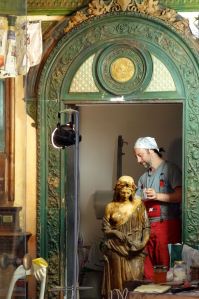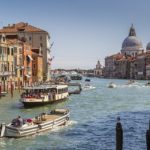Letting Fate Be Your Guide in Venice

It’s early morning. 6:30 to be exact. I’ve yet to take my shower, but centuries-old buildings are bathing in amber-and rose-tinted sunlight and summon me for a visit. There’s so much to do today, and I need to maximize my time here. Ninety minutes of Venice practically all to myself is irresistible–and so achievable if you’re willing to resist the temptation to hit the snooze button.

Empty gonodoles bob sleepily in a tucked-away alcove. Vacant campi seem to sigh in relief, relishing their temporary reprieve from the weight of souvenir carts and the tourist hoards. Piazza San Marco feels simultaneously grander and more intimate when only five people and some pigeons populate the scene. It’s a photographer’s eye-candy land, and I’m gobbling it all up.
After a hot shower and re-caffeinating with a proper cappuccino, I’m ready to brave the already swarming cruise crowds that have descended upon this gem of a city. The trick is, of course, to go where they aren’t–that means avoiding everything from Piazza San Marco to the Rialto Bridge, or going off-island completely. So I do a combination of both.
In minutes, I’m on the nearby island of Murano. There are plenty of vacationers here, looking for the best deals on the island’s famous glassworks–even I keep my eyes peeled for some neck-bling for myself and gifts for loved ones back home–but it’s a nominal fraction of the multitudes on lovely Venezia right now.
I’m a sucker for chandeliers, but I’m not in the market for one.

I humor myself by visiting a glass factory’s showroom. While there are no glassblowing demonstrations today, a young and earnest Ukranian woman is “more than happy” to guide me through the vast rooms of shimmering chandeliers.
You can almost see the potential Euros gleaming in her big blue eyes. I’m a sucker for chandeliers, but I’m not in the market for one. Still, this is a great way to learn about glassmaking, and if my heart goes pitter-patter in covetous joy over blingy lighting fixtures, so be it.
To get an even broader education on Murano glass, I meander over to the island’s glass museum, Museo del Vetro. Housed in the former residence of the bishops of Torcello, its artifacts range from 15th-century pieces used as vessels for food and beverages to contemporary works designed to adorn, to decorate, and to wow.
Beyond the informative and eye-catching displays, one of the best things about this museum is its lack of crowds. What a luxury it is to linger as you wish in front of handcrafted works, to admire the detail, and to appreciate the artistry and skill it takes to go into any single one of these pieces.
I never remember the name of this place and can only “feel” which streets to turn on.
Back on Venice, my stomach alerts me that it must be time for pranza or lunch. Still on my mission to be where the tourists are not, I head over towards sestiere Castello (the Castello neighborhood, in the “tail” section of fish-shaped Venice) and pop into a bare-bones restaurant. I never remember the name of this place and can only “feel” which streets to turn on to get here, but it’s a favorite amongst the overall-wearing, pasta-bellied, local workers. And I trust them for good value and good quality.

Blood-sugar levels back to normal, I venture out again. The silence in this area of town impresses me and practically forces me to focus more on everything else around me: the patina of the centuries-old buildings; intricate patterns along rooflines, windows and doorframes that evoke the Byzantine influence of days gone by, and the time-polished gleam of brilliantly detailed (and sometimes not very PC) brass door knockers–”sambos” greeting visitors at your door wouldn’t cut it in The States.
Although modernity has made its presence known here, history–PC or not–still lingers and permeates everything.
She’s a wonderful tour guide, Fate.
I wander, turning at random to let Fate decide my next destination. She’s a wonderful tour guide, Fate. She lets you discover things you’d never plan to encounter. First stop: a grocery store. I didn’t need anything, but I popped in. From the nondescript façade, you’d never guess how vast the interior is.
Locals on a mission darted from aisle to aisle, picking up their daily necessities, and I wondered why this seemed like a whole other world apart from the Venice I shape in my mind. While Venice entertains 10 million guests a year, it’s home to 60,000; and embracing your curiosity, you can occasionally feel the actual small town community. Visitors tend to experience museums, churches, restaurants–you know, the touristy stuff.
Fate’s detour reminded me that while we may travel thousands of miles to see a city’s top sites, for locals, sometimes it’s just about the daily grind. And that in itself is pretty cool to see, too.

Fate led me next to Palazzo Grimani, one of 200 palaces in Venice. It was a lovely discovery. Its original architecture, scavenged marble, and surviving frescoes evoke 16th-century humanism and classicism. I easily imagined what life could’ve been like for the Grimani family–great collectors of antiquities and contemporary art who lived here from the mid-1500s until the early 19th century.
Now lovingly cared for by the state, this palace-turned-museum hosts an original Roman sculpture of The Abduction of Ganymede, along with minor works by Titiano, Tintoretto, and Hieronymous Bosch and sees a mere fraction of the visitors that the formidable Doge’s Palace does. A visit here–and a little imagination–takes you back to the Venice of centuries ago.
A visit here–and a little imagination–takes you back to the Venice of centuries ago.
Zigging and zagging my way through this fish of an island, I never worried about where I was or where I would end up. If I so chose, I could look up at signs to point me back to Rialto, San Marco, Accademia, or Ferrovia (train station)…but I did not so choose. I simply journeyed on. Venice can make lots of people nervous. It can be easy to get disoriented, but I always keep in mind that it’s pretty hard to get lost. It is just an island after all.

From sestiere Cannareggio to San Polo, through Santa Croce and in Dorsoduro, I ogled boutique displays, let savory aromas pull me toward their restaurant storefronts, sampled several flavors of gelato (in the name of research, of course),

witnessed mask-makers crafting new disguises for would-be Casanovas, and even found Mikhail Baryshnikov in an art gallery (well, I found a free exhibition of a stunning photo series he did on dance throughout the world).
As Fate would have it, I found myself at the right place at the right time.
As I turned to leave, a friend who was in town phoned me, saying he had an extra ticket for the Keith Jarrett concert at La Fenice–would I like to go? Uh, yeah! I’d never been to La Fenice, and although I’ve never listened to Keith Jarrett, you simply don’t say no to such an invitation.
And so, as Fate would have it, I found myself at the right place at the right time. Capping my discovery-filled day with my virgin visit to a world-renowned 18th-century opera house and enjoying the musical stylings of one of the world’s greatest jazz pianists, I sat silently gleeful in my red velvet box seat and relished my newest memories of Venice. And I had Fate to thank for all that.
This post was originally published on The Travelphile here. Photos by Trish Feaster and Unsplash.








